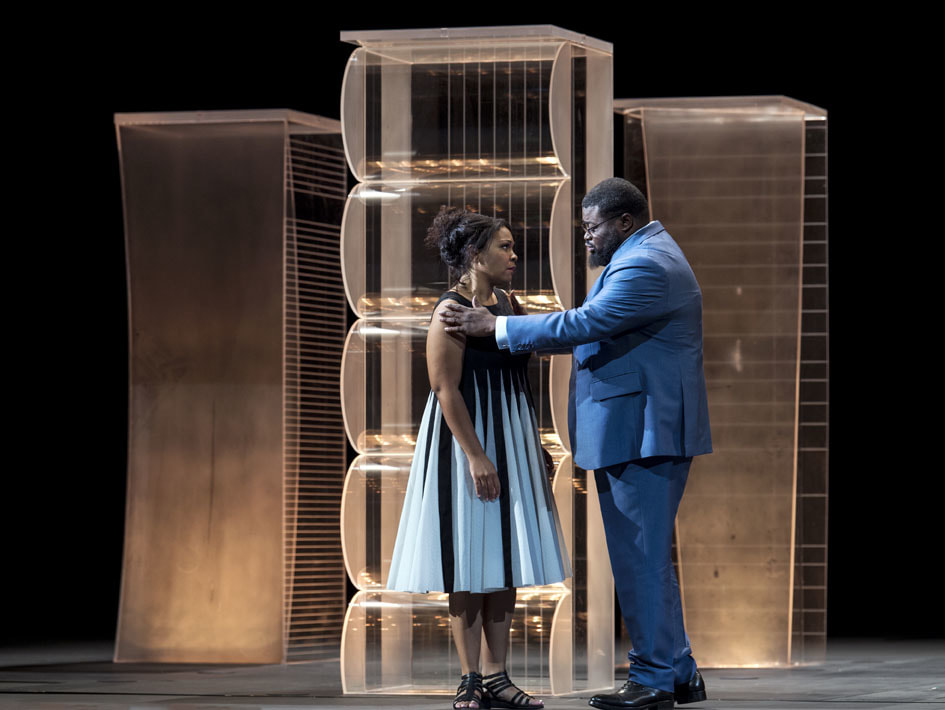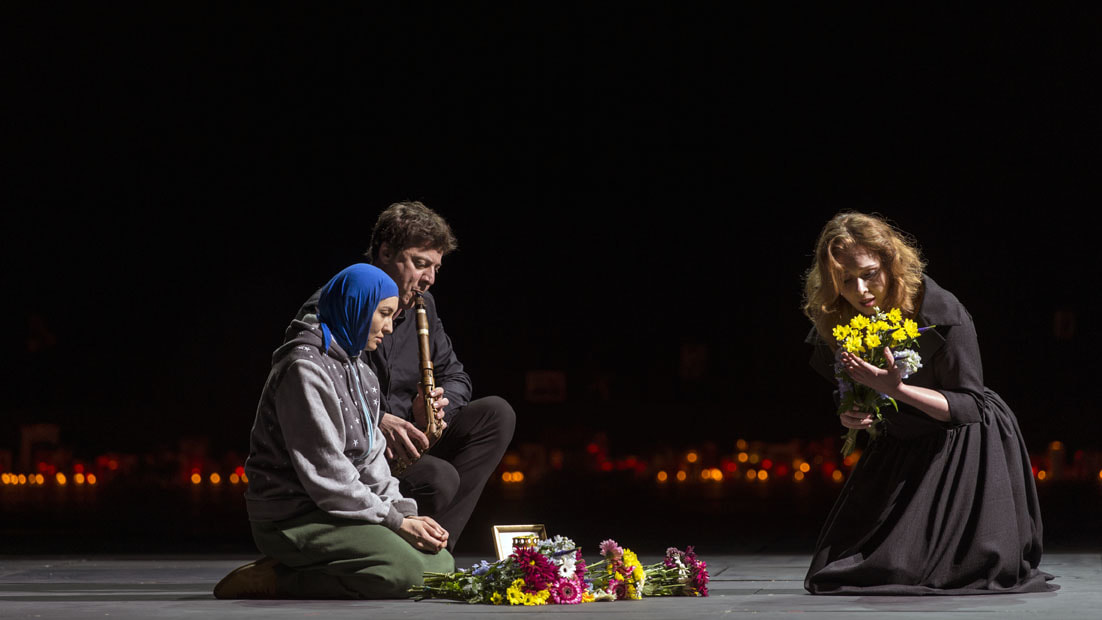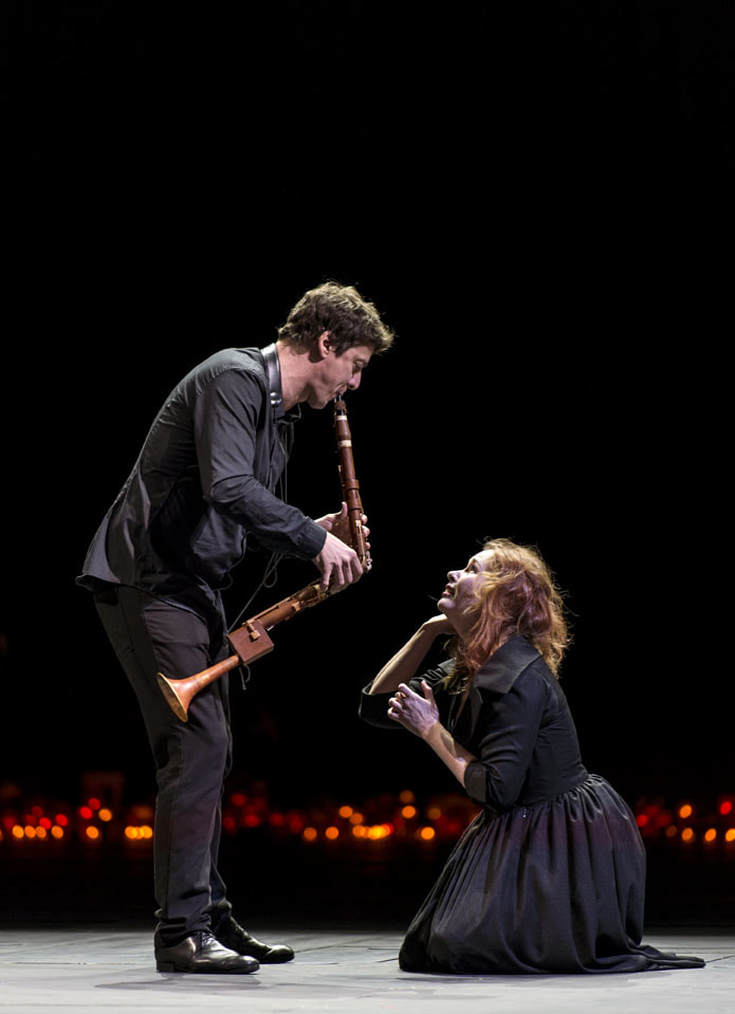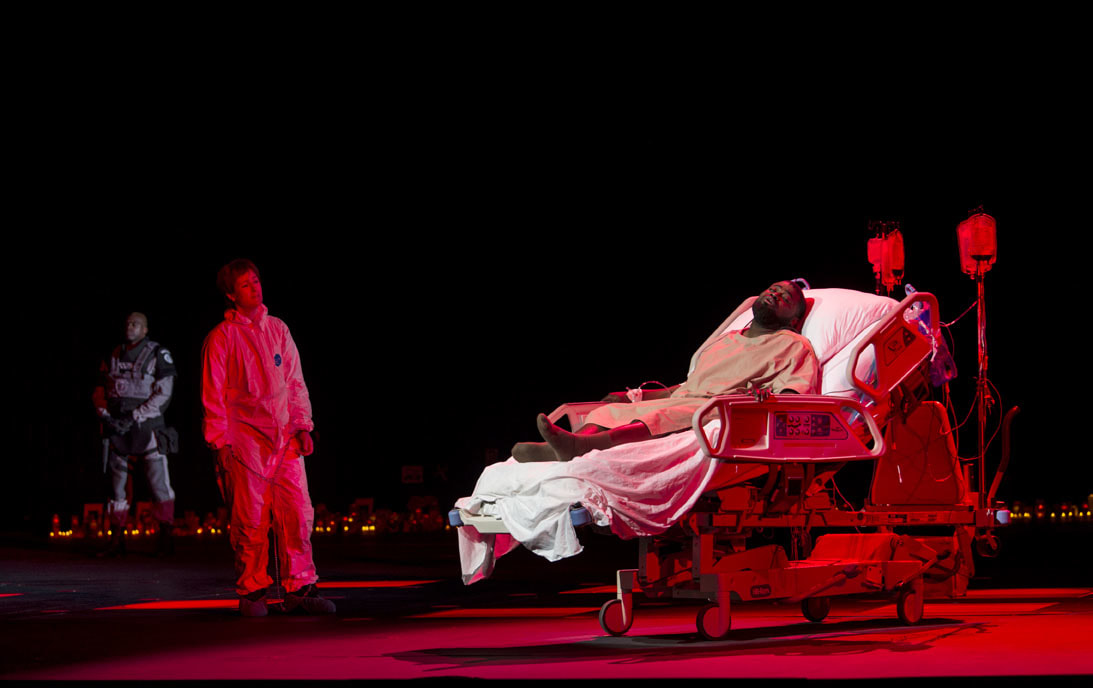La Clemenza di Tito, a production by director Peter Sellars and conductor Teodor Currentzis that supplies Mozart's last opera with a topical outlook. After Salzburg and Berlin it visits Amsterdam. A wave of horror went through the Muziektheater. It had just been announced that Teodor Currentzis was ill and had to leave his duties as conductor for this afternoon's performance to his assistant Artem Abashev. Currentzis, the Greek-Russian boy wonder of classical music, has become an attraction on his own. A self-proclaimed saviour determined to give the genre that is, supposingly or not, on life support a much needed shot in the arm. (Here classical music meets heavy metal, if I had to believe the media the latter is in a state of deadlock for as long as I can read.) I was not able to judge whether it made a big difference or not - I did not see another performance to compare - but it can be assumed that this La Clemenza di Tito, a production which, after Salzburg and Berlin, is in its third series of performances, with an assistant-conductor who was closely involved in the rehearsals, was carried out entirely according to Currentzis's wishes. A HIP-style approach with swift tempi and contemplative slow-downs - executed with the energy that can be expected from an orchestra of which the majority of its musicians play their parts while standing on their feet. Besides the orchestra and its enigmatic conductor there was Peter Sellars who gave the opera a contemporary look and there was, of course, Mozart. Above anything else, there was Wolfgang Amadeus Mozart. Because, as is often the case with opera productions in which directors expressly seek their own added value in centuries-old repertoire, it became (also here) vividly clear that it is ultimately the music that remains. La Clemenza di Tito is an opera, a rush job, written by a man, Salzburg's most famous son, who at the time of accepting the assigment only had six months to live. It is an opera (as demonstrated by the semi-concertant performance with which the Orchestra of the Eighteenth Century toured Holland last year) that can stand on its own feet. Whether this Sellars/Currentzis production is a valuable addition to the catalogue of Mozart-operas, and that of La Clemenza di Tito in particular, others may decide, certain is that Sellars (who has passed 60) lives up to his reputation of enfant terrible for those who are attached too strong to tradition. In this production Sellars does what he does more often, making connections between past and present, explicitly seeking the involvement of topical subjects. Things that should otherwise not matter (the colour of the cast) receive their place in the narrative while things that are drawn to current events (e.g Sesto becoming a terrorist) inadvertently emphasize that it is not Mozart's opera that needs saving from oblivion but Sellars', undoubtedly, good intentions. Sellars adapts Tito's story and together with Currentzis he brings other pieces of Mozart's oeuvre to the show. The addition of extra music in a for this occasion adapted storyline works wonderfully well in the first act. The Adagio & Fugue gives, for instance, an extra depth to Sesto's reflections on his role in the rebellion against Tito and the two pieces from Missa KV 427 (Benedictus & Hossanna and Laudamus te), brought in to honour Tito, grow into an excellent showcase for the choir of musicAeterna - it is pure gold that sounds here. But what works well before the break decends into emo-kitsch in the second half. In the second act, we make a jump to the recent past: the attacks, and their aftermath, in Paris, Brussels, Nice and Manchester. We see a wake with flowers and candles in commemoration of the victims, in which the Kyrie from the aforementioned Missa serves as a kind of John Lennon's Imagine on piano. It are images that are still too fresh to make an impression in the theatre. Where the adjustments of Sellars before the break feel natural, they loose their credibility in the second part. Tito turns into a soap that unintentionally reveals that the original libretto was not so bad to begin with. In the original libretto Tito is supposed to be dead after Sesto attacks him, he seems to be alive after all when it turns out that another man was stabbed by Sesto in Tito's place. Sellars thinks of this as weak dramaturgy (indeed) so he lets Sesto attack (and wound) Tito, visibly for the audience, after which Sesto, after having been imprisoned and handcuffed, is happily left alone with Tito on his deathbed (the perhaps not so strong original dramaturgy is replaced here by something as equally, if not more, far-fetched). Tito, initially determined to punish his good friend's betrayal with death, grants Sesto mercy. On the Mauerian Trauermusik, in the face of a grieving crowd, the generous king, as a major departure from the original plot, eventually dies of his wounds. From the aforementioned production of the Orchestra of the Eighteenth Century, we again encounter the Irish mezzo-soprano Paula Murrihy in the role of Sesto. As a mezzo-soprano in a male role (it regularly occurs in Mozart) she/he is a white traitor of a black king. Tito, fiercely sung by Russell Thomas, and his courtiers are all black, with Annio, a beautiful role of Jeanine De Bique (another mezzo-soprano in a male role) as his confidant. In the Vitellia of Ekaterina Scherbachenko, anger and despair are fighting a vicious fight with each other. A inner struggle that is made explicit in the scene - I found it one of this staging's stronger ideas - in which she is joined on stage by Florian Schüle, whose basset horn sounds like her inner voice. Janai Brugger is a sensitive Servillia and the cast, where it comes to the most important roles, is completed by the warm bass of Dutch National Opera-veteran Sir Willard White. In this production, La Clemenza di Tito is a piece of music theatre that makes its case not so much for Tito-the-opera as for the Mozart-the-composer. The overly adapted storyline, the eagerness to make an emotional impact and the frantic attempt to stay on top of the news in an opera production, triggers an, all too strong, attention-shift from staging to music. For all what goes wrong (mainly in the second part) we get back a beautiful final chorus, excellent, but the music becomes, by that time, more a soundtrack to invented scenery than part of a coherent whole. It is therefore, with the music of the divine Mozart still ringing in my ears, that for a future return to this production an audio-only document will most likely suffice. The Dutch National Opera 13 May 2018 Dates 7 May until 24 May 2018 Musical director: Teodor Currentzis (Artem Abashev conducted on 13 May) Orchestra: MusicAeterna Chorus: MusicAeterna Stage director: Peter Sellars Tito Vespasiano: Russell Thomas Vitellia: Ekaterina Scherbachenko Servilia: Janai Brugger Sesto: Paula Murrihy Annio: Jeanine De Bique Publio: Sir Willard White - Wouter de Moor
0 Comments
Leave a Reply. |
TIMELINE
July 2024
|






 RSS Feed
RSS Feed